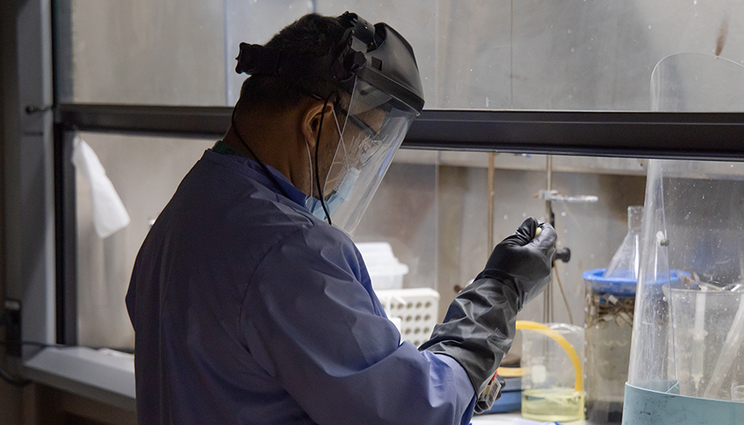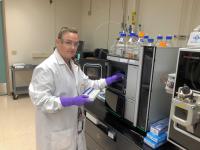Lab earns 'A' grade in OPCW test
 (Download Image)
(Download Image)
Synthetic organic chemist Saphon Hok, who works in the Forensic Science Center, carefully uses a pipet to transfer a reagent into a synthesis reaction vial that will generate an authentic reference material used to verify a proficiency test result.
In another month-and-a-half, a score of chemists from Lawrence Livermore National Laboratory's Forensic Science Center (FSC) will start two weeks of long days to undertake the Organization for the Prohibition of Chemical Weapons (OPCW) environmental proficiency test.
Livermore chemists have been taking the proficiency tests each October since 2001, with LLNL serving as one of two United States laboratories certified to test for chemical weapons since 2003.
“Each year, we become a little anxious as the proficiency test date nears and we start to prepare our instrumentation and our quality control samples,” said Armando Alcaraz, the principal investigator for the Lab’s OPCW efforts since 2001.
“But there’s also the excitement and challenge of working to do our best possible job to identify the unknowns that are in the samples.”
This year’s test offers a new wrinkle for the Lab team in the wake of the SARS-CoV-2 virus. They already have started discussions on how to perform their work with the proper COVID-19 precautions.
“Our group meetings are very important for us to share ideas and to solve challenges from the samples as we identify them. We’ve reserved an auditorium to accommodate social distancing,” Alcaraz said.
Every October, Livermore scientists and those from other laboratories around the world attempt to identify any “suspected” chemical weapons compounds in six samples within a 15-day period in the proficiency tests.
To retain their OPCW certification, LLNL and other OPCW-designated laboratories must maintain a three-year rolling average of at least two “A” grades and one “B” in the ongoing tests.
“The chemical analysis capability that is exercised through the OPCW proficiency tests is foundational to much of the research and real-world sample analysis we perform in the FSC,” said Director Audrey Williams.
In last fall’s 46th OPCW environmental proficiency test, the FSC chemists scored an “A” grade for the 10th straight year.
The test started last Oct. 21 when six samples were shipped to the FSC laboratory: three organic liquid waste samples and three aqueous waste samples. The test ran for 15 days, ending Nov. 5.
The Livermore researchers correctly identified all nine reportable spiked chemicals under the test’s “scenario” of samples collected from a university organic synthesis laboratory accused of performing chemical weapons research.
See related story: "LLNL also an OPCW-designated lab for biomedical samples"
“This was another challenging and realistic proficiency test,” Alcaraz said. “The samples were chemically complex, contained a red herring (if reported, it would result in an “F” grade) and a reportable spiked compound appearing to be a red herring (diethylphosphate). Labs that did not report diethylphospate (11 out of 20 labs) dropped a letter grade for the false negative result; fortunately, our team recognized this chemical as a degradation product of amiton, a Chemical Weapons Convention (CWC) schedule chemical.”
LLNL received its original OPCW certification in 2003. Its work is carried out by the Laboratory's FSC, which is part of the Global Security Principal Directorate and is funded by the National Nuclear Security Administration’s Office of Nuclear Verification (NA-243).
The other U.S.-designated laboratory is the Aberdeen Proving Ground, Maryland-based U.S. Army Combat Capabilities Development Command Chemical Biological Center (formerly Edgewood Chemical Biological Center).
The OPCW oversees compliance for the Chemical Weapons Convention treaty, which has been in force since 1997 and currently has 193 nations or state parties.
Under the CWC treaty, the development, production, acquisition, stockpiling and use of chemical weapons is banned, as is the transfer of chemical-weapon-related technologies.
The samples for last October's proficiency test, taken by LLNL and 18 other laboratories around the world, were prepared by the TNO Laboratory of The Netherlands. The participating laboratories' test reports were then evaluated by the Defence Science and Technology Laboratory from the United Kingdom.
Out of the 20 laboratories that participated in the October OPCW proficiency test, eight earned “A” grades, seven received “Bs,” two garnered “Cs,” two received “Ds” and one took the proficiency test as a trial participant.
Three of Livermore's “A” grades over the past 10 years, including its 2018 grade, have been received for serving as the OPCW's evaluation lab, grading reports.
In addition to Alcaraz and Williams, other Lab researchers participating in the fall OPCW proficiency test were: Deon Anex, Sarah Chinn, David Cho, Todd Corzett, Mark Dreyer, Saphon Hok, Carolyn Koester, Roald Leif, Rachel Lindvall, Katelyn Mason, Brian Mayer, Daniel Mew, Tuijauna Mitchell-Hall, Mari Prieto-Conaway, Michael Riley, Edmund Salazar, Robert Schmidt, Carlos Valdez and Alexander Vu.
Contact
 Stephen Wampler
Stephen Wampler
[email protected]
(925) 423-3107
Related Links
LLNL Forensic Science CenterOrganization for the Prohibition of Chemical Weapons
Related story: "LLNL also an OPCW-designated lab for biomedical samples"
Tags
Bioscience and BioengineeringBiosciences and Biotechnology
Forensic Science Center
Advanced Materials and Manufacturing
Materials Science
Nuclear, Chem, and Isotopic S&T
Nuclear and Chemical Sciences
Global Security
Physical and Life Sciences
Featured Articles








